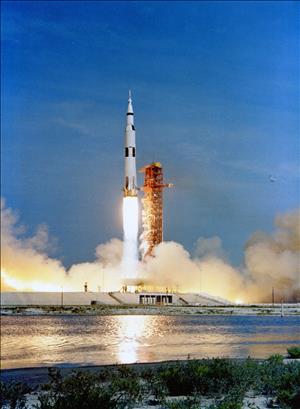On July 16, 1969, three astronauts aboard Apollo 11 lift off from Cape Kennedy and head for a walk on the moon. Apollo is sent hurtling on the 238,000-mile trip to the moon by 7.5 million pounds of thrust from the Boeing-built S-1C first stage booster of the Saturn V launch vehicle, the largest American rocket ever constructed. Boeing staff also coordinated Apollo "Technology Integration and Evaluation," including pressing the button that launched human beings on their first visit to another celestial body. On July 19 astronauts Neil Armstrong, Edwin "Buzz" Aldrin, and Michael Collins will begin orbiting the moon. The next day Armstrong and Aldrin, in the lunar module Eagle, will land on the moon's Sea of Tranquility.
A Giant Leap for Mankind
All over Washington, people turned their television sets on to watch the live transmission. In Seattle nearly 2,000 people watched the landing at the Pacific Science Center at Seattle Center. "Twenty minutes before touchdown, people stood spellbound watching the large screen and listening to the conversations of Mike Collins with Mission Control ... Tension in the theater increased as the little space taxi named Eagle slowed to 3 miles per second two miles from the moon. Moments later, Collins could be heard saying, 'The engines have stopped.' With that, the theater exploded into wild applause. Strangers thumped one another on the back. Some wept" (Seattle Post-Intelligencer). A short time later Armstrong made the first moon footprint with the words "That's one small step for a man, one giant leap for mankind."
On the two-and-one-quarter-hour moonwalk, Armstrong and Aldrin collected 47 pounds of rock. The lunar module was on the moon for 21 hours and 36 minutes before returning to the orbiting command module. Apollo returned and splashed down safely in the Pacific Ocean on July 24.
Boeing's involvement in the Apollo program was significant. On January 4, 1966, at New Orleans, The Boeing Company started construction of the first stage of Saturn V. The 12-story-high S-1C booster was assembled and completed by May 8, 1967, then tested and barged to Cape Canaveral. At the Cape, the three stages of the Saturn V launch vehicle and the Apollo 11 capsule were assembled under Boeing's supervision. On May 20, 1969, the 36-story high rocket was rolled out to Pad A at Launch Complex 39 to prepare for launch. Following a fatal Apollo capsule fire on January 27, 1967, NASA hired Boeing to coordinate Technical Integration and Evaluation of all Apollo systems. Boeing was also involved in designing and building navigation systems and the Lunar Rover employed on later visits to the moon. The SI-C booster was last used on May 14, 1973, to launch Skylab into Earth orbit.

